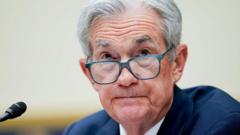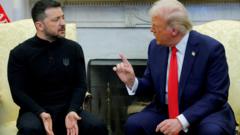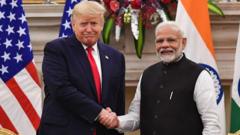China is leveraging its substantial economic might and rare earth monopoly to counter U.S. tariffs, focusing on long-term growth and strategic partnerships.
Trade Tensions: China's Strategic Moves in the US Trade War

Trade Tensions: China's Strategic Moves in the US Trade War
Amidst escalating tariffs, China pivots with a multi-faceted strategy.
A trade conflict between the two largest economies is now intensifying, with new tariffs reaching as high as 245% on Chinese goods entering the U.S. In retaliation, China has imposed a hefty 125% tax on American imports. This escalating tug-of-war surrounds consumers and global markets with a shroud of uncertainty, triggering concerns regarding a potential recession worldwide. President Xi Jinping’s administration asserts a willingness to negotiate; however, it maintains a firm stance, ready to "fight to the end" if needed. Here’s an overview of the strategic assets China possesses in this ongoing trade tussle.
**China’s Capacity for Resilience**
Unlike President Trump, who faces electoral accountability, Xi's regime has the liberty to absorb economic impacts in the short term. With a vast domestic market and a foundational economy, China has the potential to cushion its industries against the brunt of tariffs. Although domestic consumption has stalled, various incentives, from subsidies to promotions for retirees, signal possible revitalization. Experts suggest that Beijing may endure initial economic distress to stand firm against what it views as U.S. hostilities. Additionally, as an autocracy, the Chinese government isn't overly concerned about immediate public sentiment or vote outcomes, although citizen unrest stemming from economic discontent remains a looming concern.
**Investment in the Future**
China is positioning itself beyond its identity as a manufacturing hub; it’s pivoting towards cutting-edge technologies like AI and electric vehicles, having invested significantly in these industries. Notable achievements such as BYD becoming the largest electric vehicle manufacturer exemplify this transition. China's commitment to boosting innovation remains steadfast, allocating over $1 trillion toward technological advancement over the next decade. Even as American firms aim to relocate supply chains, they find it challenging to match the scale and expertise that Chinese manufacturers provide.
**Shifting Trade Dynamics**
In direct response to increasing tariffs, Beijing has intensified efforts to forge trade relationships beyond the U.S. With initiatives like the Belt and Road, China seeks to ensure collaboration with developing nations across Southeast Asia and Africa. The significance of this strategy is illustrated by China’s lowering dependence on U.S. imports, having notably shifted the balance of its soybean suppliers towards Brazil following earlier trade conflicts.
**Strategic Financial Position**
China, holding $700 billion in U.S. government bonds, retains a financial leverage point over the U.S. market. Past events show that tariff-induced sell-offs have prompted shifts in U.S. policy, making China's position precarious yet influential. However, experts caution that wielding significant U.S. debt could backfire and cause instability within China's own economic framework.
**Rare Earths Monopoly**
One of the most formidable tools in China's arsenal is its near-total control over rare earth elements, essential in the production of advanced technologies. Currently controlling 92% of refining capacities, China has already enacted export restrictions on various rare earths in response to U.S. tariffs. This move could have cataclysmic consequences for U.S. industries reliant on these materials, emphasizing the delicate balance in the international trade ecosystem.
In conclusion, as trade tensions continue, China's strategic position — fortified by economic resilience, significant investment in future industries, and control over critical resources — presents a complex challenge for the U.S. as both nations navigate the choppy waters of international trade.























